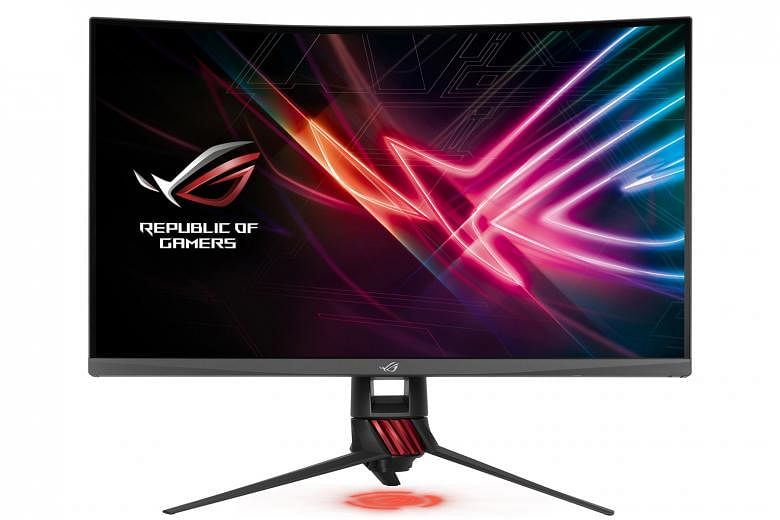Gamers are spoilt for choice when it comes to gaming monitors. Having just launched the 27-inch ROG Swift PG27VQ in January, Asus has introduced another monitor.
The new ROG Strix XG32VQ (right) deviates significantly from the Swift in certain key aspects, such as its larger 31.5-inch screen size and the panel type. But the two have similar aesthetics, such as a stubby, curved design, narrow bezels and flashy LEDs that can synchronise with compatible Asus hardware.
They have an identical 2,560 x 1,440-pixel screen resolution. Despite being curved monitors, they are not ultra-wide, but conventional 16:9 displays. As a result, these Asus monitors do not wrap around you like ultra-wide 21:9 screens and hence, feel less immersive to me.
A major differentiator between the two is the type of display. The Strix uses a vertical alignment (VA) panel while the Swift has a twisted nematic (TN) screen.
The difference is night and day. The Strix's VA panel looks more vibrant with better viewing angles compared with the washed-out appearance of the TN-based Swift.
But in terms of response rate (lower is better for gaming), the 4 milliseconds (ms) quoted for the Strix is not as good as the Swift's 1ms. Hence, the Strix is more suitable for mixed usage such as watching videos and editing photos.
- TECH SPECS
-
PRICE: $939
RESOLUTION: 2,560 x 1,440 pixels
ASPECT RATIO: 16:9BRIGHTNESS: 300 cd/m2
RESPONSE TIME: 4ms
PANEL TYPE: Vertical alignment
CONNECTIVITY: DisplayPort, HDMI, mini-DisplayPort, 2 x USB 3.0 downstream, headphone jack
RATING FEATURES: 4/5
DESIGN: 4/5
PERFORMANCE: 4/5
VALUE: 4/5
OVERALL: 4/5
But the Strix is designed for gaming too. It has a high refresh rate of up to 144Hz and supports AMD's FreeSync technology, which dynamically adapts the monitor's refresh rate to the game's frame rates. This ensures a smooth, tear-free experience.
On the Strix, this feature kicks in when games are running at 48 to 144 frames per second. As FreeSync works only with AMD graphics cards, those with a Nvidia graphics card would find the Swift PG27VQ, which supports Nvidia's equivalent G-Sync technology, more suitable.
Although it is fairly bulky, the range of adjustment available for the Strix is impressive. It can swivel up to 50 degrees to the left or the right. The height can be adjusted and the monitor can be tilted towards or away from the user. It can be wall-mounted using a Vesa bracket.
I prefer using a joystick to navigate a monitor's on-screen display setting (OSD) and, thankfully, the Strix offers this. The OSD has a bunch of gaming features, from a selection of aiming reticles to a countdown timer. There are also preset profiles such as an FPS (first-person shooter) mode that drastically increases the screen brightness for FPS games.
There is also a Moba (multiplayer online battle arena) profile that turns most colours (except red and black) grey, presumably to prevent gamers from being overwhelmed by the visual effects used in such games.
Out of the box, the Strix seems to be decently calibrated. I had to make only minor adjustments to get the perfect calibration.
Despite its bigger screen, the Strix ($939) costs less than the Swift ($1,399). Part of the reason is the licensing fee required for Nvidia G-Sync support, as well as the Swift's higher 165Hz refresh rate.
- Verdict: The Asus ROG Strix is a big-screen gaming monitor best paired with an AMD graphics card.


